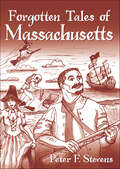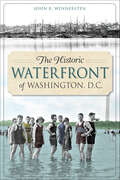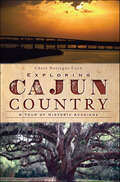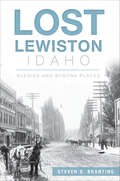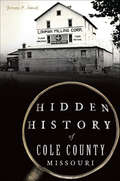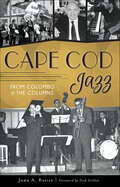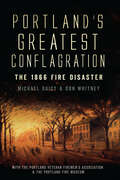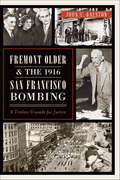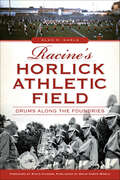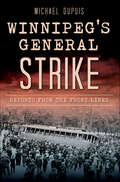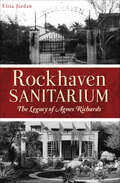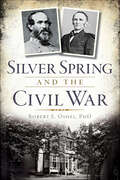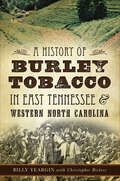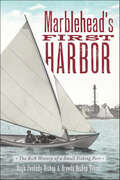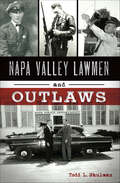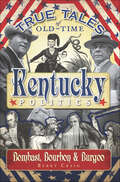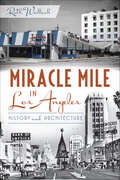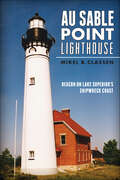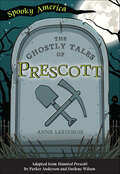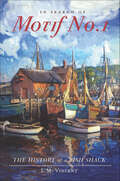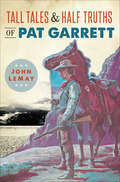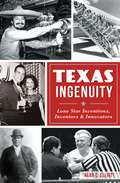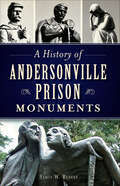- Table View
- List View
Forgotten Tales of Massachusetts (Forgotten Tales)
by Peter F. StevensW hen the first Pilgrims arrived on the shores of Massachusetts, they set foot in a world full of promise and new beginnings. Colonists witnessed the births of new children, governments and traditions, but even the Puritans could not wholly escape the Old World�s basest human instincts. In Plymouth, John Billington committed the nation�s first murder, and in Boston, the �Mass Bay Madam� Alice Thomas opened the first brothel. A Charlestown midwife and healer was hanged for witchcraft. Yet Massachusetts also produced William Phips, America�s first undersea treasure hunter; Peter Salem, the first black war hero; Ann Bradstreet, pioneer poetess; and William Ives, printer of the first board game. In these dramatic and vividly imaginative tales, Peter Stevens narrates fascinating episodes from Massachusetts history, piecing together forgotten yet essential aspects of American identity.
The Historic Waterfront of Washington, D.C. (Landmarks)
by John R. WennerstenThe waters of the Potomac and the Anacostia Rivers surround and define the nation's capital. For centuries, these rivers have been manipulated environments--transformed by native populations, settlers, politicians and real estate developers. With docks and wharves extending from the Anacostia River to Georgetown, the architect of the young capital, Pierre L'Enfant, planned to develop the waterfront into a prosperous inland seaport. Decades later, the Civil War took a devastating toll on the District's maritime economy with civilian port facilities pressed into military service and the failure of many riverfront plantations. Author John R. Wennersten explores this early history of Washington, D.C.'s waterfront even as he tackles its twentieth-century redevelopment and the challenges the rivers face today.
Exploring Cajun Country: A Tour of Historic Acadiana (History & Guide)
by Cheré Dastugue CoenLouisiana's famous Cajun Country is a place where today's travelers can still experience the rich heritage and traditions that began in the eighteenth century.From foodways and folktales to music and festivals, Acadiana offers something you can't get anywhere else. Journey through this historic and unique part of the state with travel writer and historian Cher Coen as your guide Experience Cajun Country through its exceptional cuisine, area events, and historic attractions.
Lost Lewiston, Idaho: Elegies and Bygone Places (Lost)
by Steven D. BrantingLewiston has a proud heritage of historic preservation. Yet, as with other communities, it has neglected and thrown away once-treasured landmarks and precious memories with the passage of time. Some legacies were crafted with brick and mortar, others with flesh and blood. Nothing is permanent unless we make it so. Join award-winning historian Steven D. Branting as he takes a focused look at some of Lewiston's bygone edifices and the ambitious civic leaders and craftsmen who fashioned them. Reconnect with the city's scholars, its pious, its dreamers and one desperate teenager. They all made Lewiston what it once was, bequeathed their present to be our past and have sadly faded from our view.
Hidden History of Cole County, Missouri (Hidden History)
by Jeremy P. ÄmickHistoric tales lie in the shadows throughout Cole County, notably in the vicinity of Russellville, Lohman and Stringtown. Pioneers such as Enoch Enloe found a home near Russellville following a broken wagon wheel while making the journey west in the 1830s. Stringtown has become a forgotten town that was once home to a self-proclaimed doctor who was brutally murdered. Millbrook claims business-minded visionaries such as John Scheperle Sr., who helped establish the legendary Centennial Mill. A few miles north in Lohman, the railroad became the impetus for growth and ushered in a period of relative prosperity. Historian and author Jeremy P. Ämick uncovers many fascinating tales passed down through the years.
Cape Cod Jazz: From Colombo to The Columns
by John A. BasileThe first notes of jazz hit Cape Cod in the very early days of the genre. Bournehurst-on-the-Canal hosted top bands, and emerging swing era dancers packed the hall. Cape Cod's "First Lady of Jazz," Marie Marcus, was a child prodigy in Boston and found some of her most important instruction in the art of stride piano during lessons with great pianist Fats Waller in New York. At the very tip of the Cape, the Atlantic House in Provincetown showcased performances from some of the biggest names like Gerry Mulligan, Billie Holiday and Stan Getz. Author John Basile details the fascinating history and amazing musicians that made Cape Cod a music destination.
Wisconsin at Antietam: The Badger State’s Sacrifice on America’s Bloodiest Day (Civil War Series)
by Cal SchoonoverThe Battle of Antietam was the bloodiest day in American history, and Wisconsin played a vital role. The Second, Sixth and Seventh Wisconsin Regiments served in the Iron Brigade, one of the most respected infantries in the Federal army, and fighting by their side in Maryland was the Third Wisconsin. The mettle of the Badger State was sorely tested and proven on South Mountain and on the bloody Miller's Cornfield. The Third alone lost more than half its men to death or injury, and the Iron Brigade, too, suffered extraordinary losses. Yet Wisconsin's sacrifices at Antietam rebuffed the Confederate incursion into Northern territory and enabled the Emancipation Proclamation. Civil War historian Cal Schoonover sheds new light on the exploits of Wisconsin soldiers in this turning point to secure the Union.
Portland's Greatest Conflagration: The 1866 Fire Disaster (Disaster)
by Don Whitney Michael Daicy The Portland Fire Museum Portland Veteran Firemen's AssociationOn the Fourth of July in 1866, joy turned to tragedy in Portland, Maine. A boy threw a firecracker onto a pile of wood shavings and it erupted in a blaze as residents prepared to celebrate the 110th anniversary of American independence in the momentous time following the Civil War. The violent conflagration killed two people and destroyed all structures on nearly thirty streets. Authors Michael Daicy and Don Whitney, both firefighters, chronicle the day's catastrophic events, as well as the bravery of those who fought the ferocious fire, dispelling the myth that ill-trained firefighting contributed to the devastation.
Fremont Older and the 1916 San Francisco Bombing: A Tireless Crusade for Justice
by John C. RalstonOn Saturday, July 22, 1916, as "Preparedness Day" parade units assembled south of San Francisco's Market Street, a terrorist bomb exploded, killing ten people and wounding forty. San Francisco was outraged. Instead of searching for the perpetrators, however, the district attorney used the bombing as an excuse to arrest, try and convict two obscure labor figures without evidence. Author John C. Ralston chronicles the dramatic events following the initial tragedy as newspaper editor Fremont Older discovers the case is based on blatant perjury and exposes the secondary crime to the public. What became known as the "American Dreyfus Case" led to an international outcry, finally resulting in one defendant's pardon and the other's parole--but only after both men had been imprisoned for twenty-three years..
Racine's Horlick Athletic Field: Drums Along the Foundries (Landmarks)
by Alan R. KarlsLaunched in 1919 by William Horlick, the inventor of malted milk, Horlick Athletic Field has hosted two NFL teams, the Racine Belles professional women's baseball team (immortalized in "A League of Their Own)" and thousands of semiprofessional- and industrial-league games. But it is the drum and bugle corps shows that have made the stadium one of the most iconic landmarks in its corner of the state. From an archive of fond recollection and painstaking record, Alan Karls has pieced together a history of Horlick Athletic Field that justifies the reverence that drum and bugle corps have felt for the place for almost a century.
Winnipeg's General Strike: Reports from the Front Lines
by Michael DupuisAn exploration of the impact the media had on the most influential strike in Canadian history. A strike gripped Winnipeg from May 15 to June 26, 1919. Some twenty-five thousand workers walked out, demanding better wages and union recognition. Red-fearing opponents insisted labour radicals were attempting to usurp constitutional authority and replace it with Bolshevism. Newspapers like the "Manitoba Free Press" claimed themselves political victims and warned of Soviet infiltration. Supporters of the general sympathetic strike like the "Toronto Daily Star" maintained that strikers were not Reds; they were workers fighting for their fair rights. What was really happening in Winnipeg? In an information age dominated by newspapers and magazines, the public turned to reporters and editors for answers.
Rockhaven Sanitarium: The Legacy of Agnes Richards (Landmarks)
by Elisa JordanFor decades, the mild climate of the Crescenta Valley served as a haven for those seeking mental health rest and relief from lung ailments. In 1923, registered nurse Agnes Richards decided it was the perfect place to open a sanitarium, one that would set itself apart from the rest. Rockhaven Sanitarium catered to female residents only and, with few exceptions, exclusively employed women. It was a progressive treatment center that prided itself on treating residents with dignity and respect. The center's high ideals and proximity to early Hollywood attracted residents like Billie Burke; Marilyn Monroe's mother, Gladys; and Clark Gable's first wife, Josephine Dillon. Join author Elisa Jordan as she explores Rockhaven's illustrious past.
Silver Spring and the Civil War (Civil War Series)
by Robert E. OshelOn July 11, 1864, some residents cheered and others watched in horror as Confederate troops spread across the fields and orchards of Silver Spring, Maryland. Many fled to the capital while General Jubal Early's troops ransacked their property. The estate of Lincoln's postmaster general, Montgomery Blair, was burned, and his father's home was used by Early as headquarters from which to launch an attack on Washington's defenses. Yet the first Civil War casualty in Silver Spring came well before Early's raid, when Union soldiers killed a prominent local farmer in 1862. This was life in the shadow of the Federal City. Drawing on contemporary accounts and memoirs, Dr. Robert E. Oshel tells the story of Silver Spring over the tumultuous course of the Civil War.
A History of Burley Tobacco in East Tennessee & Western North Carolina
by Billy YearginBurley tobacco revolutionized the industry in east Tennessee and western North Carolina. What started from two farmers planting white burley in Greeneville ignited an agricultural revolution and significantly changed crops, production and quality. Burley transformed the tobacco industry with new cultivation techniques and a shift from dark and flue-cured tobacco. By the 1990s, burley tobacco production in the region had drastically declined, and it is a tradition that few local farmers still practice. Agricultural experts Billy Yeargin and Christopher Bickers take a nostalgic look at the historic rise of burley tobacco and its gradual decline.
Marblehead's First Harbor: The Rich History of a Small Fishing Port (Maritime Ser.)
by Hugh Peabody Bishop Brenda Bishop BoomaThe true beauty and fury of the Atlantic Ocean are known only by the rugged individuals who have made their living from the sea. In the seventy-five years from the American Revolution to the middle of the nineteenth century, Marblehead, Massachusetts, experienced a golden age of fishing. For the next fifty years, the industry struggled, but from 1900 until the end of the twentieth century, one small anchorage made itself proud. From boat building to sail design, First Harbor produced creative men whose innovations helped shape marine history. Join Hugh Peabody Bishop and Brenda Bishop Booma as they reveal this story through the eyes of a Marblehead fisherman, drawn uncontrollably by his love for the sea.
Napa Valley Lawmen and Outlaws (True Crime)
by Todd L. ShulmanLaw enforcement in Napa County traces its roots back to the days of Spanish rule and was formalized when California became a state in 1850. Since then, those who wear the badge have pursued the lawless in search of justice. Chuck Hansen, who started as a patrol officer, pioneered the use of forensic science at the Napa Police Department, collecting DNA evidence in 1974 that would become key in solving a murder decades later. And the killer known as "Willy the Woodcutter" was caught thanks to the expertise of Hal Snook of the Napa County Sheriff's Department. Napa police sergeant Todd Shulman brings to life the stories of those who played a part in solving some of wine country's most infamous crimes.
True Tales of Old-Time Kentucky Politics: Bombast, Bourbon & Burgoo
by Berry CraigDid you know that William Goebel of Kentucky remains the only state governor to be assassinated while in office? Or that Abraham Lincoln, now a favorite son of the Bluegrass State, garnered less than 1 percent of the state's vote in 1860? How about Matthew Lyon, the congressman who won reelection from a jail cell and once bit off the thumb of a voter during a brawl on the House floor? These are but three of the fascinating and little-known stories from Kentucky's political past found in True Tales of Old-Time Kentucky Politics. Join longtime columnist Berry Craig as he shares tales of a time when votes could be bought with a drink and political differences were resolved with ten paces and a pistol.
Miracle Mile in Los Angeles: History and Architecture
by Ruth WallachThe world-famous Miracle Mile in Los Angeles was shaped into a great commercial and cultural district by the city's tremendous urban expansion in the early twentieth century. Its origins along Wilshire Boulevard are directly related to the twin LA booms in auto travel and real estate ventures. Once the home of such famous stores as the May Company, Silverwood's, Coulter's and Desmond's, as well as Streamline Moderne and Art Deco architecture, Miracle Mile has boasted the La Brea Tar Pits and Farmer's Market, Gilmore Field and CBS Television City, as well as Pan Pacific Park and Museum Row. Join author Ruth Wallach, head of the University of Southern California's Architecture and Fine Arts Library, for this tour through the most emblematic neighborhood of twentieth-century Los Angeles development.
Au Sable Point Lighthouse: Beacon on Lake Superior's Shipwreck Coast (Landmarks)
by Mikel B. ClassenSkeleton ship frames surround Au Sable Point, marking a mile-long sandstone reef that reached out into Lake Superior waiting to grab any and all ships that passed by. In an effort to end this tragic loss of lives, the Au Sable Point Lighthouse was constructed to warn mariners of its hidden reef. At the heart of the famed "Shipwreck Coast," Au Sable Point was a beacon of hope and safety. Mikel B. Classen charts the history of the lighthouse and the dangerous reef that waits six feet under the lake's surface and serves as the final resting place for so many sailors.
The Ghostly Tales of Prescott (Spooky America)
by Anna LardinoisGhost stories from Prescott, Arizona have never been so creepy, fun, and full of mystery! The haunted history of Prescott comes to life—even when the main players are dead. Visit the Palace Saloon, but be sure to watch out for bottles thrown by phantom hands! Or attend a show at the Elks Opera House, but prepare to be distracted by wandering specters. Dive into this spooky chapter book for suspenseful tales of bumps in the night, paranormal investigations, and the unexplained; just be sure to keep the light on.
In Search of Motif No. 1: The History of a Fish Shack (Landmarks)
by L.M. VincentMotif No. 1, a red fish shack, sits at the end of a granite pier in Rockport, Massachusetts. How did a humble fish house painted by numerous artists, including Aldro Hibbard, Anthony Thieme, Emil Grupp and Harrison Cady, become an icon? Author L.M. Vincent examines the shack's colorful history from its origins to the present day to answer the question. His exploration of this symbol of coastal New England, arguably one of the most painted buildings of its time, is a uniquely American story that will both inform and entertain.
See Alabama First: The Story of Alabama Tourism
by Tim HollisTourism in the Southeast is often associated with Florida--a state that essentially defined the industry in America. Yet Alabama has a fascinating history of tourism all its own. It all began with an enterprising politician. In 1916, John Hollis Bankhead went to great lengths to ensure that one of America's first transcontinental highways went directly through Alabama. Though it was a less efficient route for highway travelers, it marked the birth of Alabama's fledgling tourism industry, which grew exponentially with each passing decade. Since he was a boy, author Tim Hollis has traveled from the Shoals to the coast and amassed an unrivaled knowledge of Alabama tourism. From restored and preserved historic destinations to campy tourist traps and outrageous roadside attractions, this is the complete story of tourism in Alabama.
Tall Tales & Half Truths of Pat Garrett (American Legends)
by John LeMayWhile many lionize Billy the Kid, the man who killed him, Sheriff Patrick Floyd Garrett, has a rarely told but riveting true story all his own. His adventurous life spawned many a far-fetched, exciting legend. In 1896, Garrett's investigation of the still-unsolved murder of Albert J. Fountain on the White Sands led to nothing but a gunfight and a dead deputy. Some say that Garrett faked the details the night the Kid was brought to ultimate justice, while others swear another wannabe hero did him in. In perfect irony, Garrett's own 1908 death is shrouded in mystery. Some report he died by the hand of Billy the Kid himself. Author John LeMay exposes fabricated tales for what they are and focuses on memories long forgotten about Billy the Kid's personal grave digger, Sheriff Pat Garrett.
Texas Ingenuity: Lone Star Inventions, Inventors & Innovators
by Alan C. ElliottImagination is bigger in Texas, too. This collection of inspiring and often quirky stories highlights dozens of examples of innovation from Lone Star history. The Hamill brothers devised a better oil well to reach gushers at Spindletop. The first Neiman-Marcus store opened in Dallas in 1907, revolutionizing the retail fashion world. Astroturf emerged at the Astrodome in 1966. Fritos and corn dogs are just two ubiquitous snack foods claimed as Texan originals. Houston native, and civil rights activist, Congresswoman Barbara Jordan rose to national prominence as a voice of unity during the Watergate scandal. Author Alan C. Elliott details these and many more lessons in success in Texas Ingenuity.
A History of Andersonville Prison Monuments (Civil War Series)
by Stacy W. ReavesIn April 1865, the nation learned of the atrocities and horrors of the Southern prison camp at Andersonville, Georgia. An army expedition and Clara Barton identified the graves of the thirteen thousand who perished there and established the Andersonville National Cemetery. In the 1890s, veterans and the Woman's Relief Corps, wanting to ensure the nation never forgot the tragedy, began preserving the site. The former prisoners expressed in granite their sorrow and gratitude to those who died or survived the prison camp. Join author and historian Stacy W. Reaves as she recounts the horrendous conditions of the prison and the tremendous efforts to memorialize the men within.
